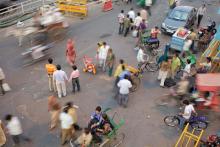Actions are planned on road safety but are they enough? - *Charles Melhuish and *Alan Ross report.
Deaths and injuries on the world's roads are now a major health concern. Road crashes now cause around 1.3 million deaths and injure or disable as many as 50 million persons globally each year. The vast majority of these deaths and injuries (over 90%) occur in low- and medium- income countries adding to their already overburdened health facilities as well as adversely affecting economic and social development

Improved safety features should be a key target for all developing road networks - picture courtesy Alan Ross
Actions are planned on road safety but are they enough? - *Charles Melhuish and *Alan Ross report
Deaths and injuries on the world's roads are now a major health concern. Road crashes now cause around 1.3 million deaths and injure or disable as many as 50 million persons globally each year. The vast majority of these deaths and injuries (over 90%) occur in low- and medium- income countries adding to their already overburdened health facilities as well as adversely affecting economic and social development. Unless urgent action is taken, these casualties are forecast to increase by a further 80% by 2020. Already, road deaths kill more people annually than major diseases such as malaria and by 2030, they will kill twice as many as AIDS/HIV and four times as many as tuberculosis. As a result, road crashes are not only resulting in large annual economic losses, typically from 2% to 3% of annual gross domestic product, but contribute to poverty in many developing countries. Road transport provides a vital contribution to economic growth but the adverse impacts of increasing vehicle fleets are given insufficient attention by planners. As the numbers of road crashes are increasing rapidly in many regions, the urgency of tackling the issue grows exponentially.The deteriorating situation has been recognised and in recent years a number of committed organisations, interested groups and influential individuals have collaborated to raise awareness. Together, they have mobilised a global response and the
The UN has declared a Decade of Action on road safety, with a global plan devised to support the decade. The Decade of Action commenced worldwide on 11 May 2011 and the target is to reduce road deaths by 50% by 2020.
Individual countries are being encouraged to develop country-specific road safety action plans, with some of the works supported by financial assistance from multilateral development banks as well as bilateral assistance programs. The development banks have agreed to provide greater emphasis and higher priority to road safety. The plight of millions of poor people affected by poor road safety has also been noticed by philanthropists who are allocating funds to tackle the issue.
The UN Regional Commissions have assisted member countries to establish regional casualty reduction targets while the
The WHO recognised the road safety problem through its significant impacts on health budgets which in most countries are severely constrained. In many locations casualty wards are full to overflowing with road crash victims and these are often the lucky individuals who make it to a treatment centre.
Substantial work needs to be done to make sure that the targets are achieved and that the global efforts are successful. Since the problem is acute in developing countries, success will depend on reducing road crashes on the road networks in Africa, Asia and South America. In developing countries, recognition of the safety problems associated with road development and its use has been slow to evolve. Since the 1990s, despite concerted efforts, road safety mitigation has been unsuccessful. Given the fast pace of economic growth in many countries, addressing road safety issues has been a tough battle as vehicle fleets in many countries have more than doubled over the past five years and the demand for mobility has increased in leaps and bounds. The growth in mobility has not only outstripped the experiences of North America or Europe but has also occurred in a different manner. Much of the growth in vehicle fleet has been dominated by two-wheeled traffic: motorcycles and scooters, which are inherently more accident-prone than cars and trucks that dominate roads in the northern hemisphere. An additional difference is that cities in developing countries feature large numbers of pedestrians, few of whom drive. The large number of two-wheeled vehicles and the volume of pedestrians, who use roads for purposes such as drying rice in rural areas or commercial activities in urban zones, mean that the road environment in a developing nation is different from that of a developed country. Tackling the problem therefore requires different processes from the traditional approaches that have been adopted in the past by most traffic planners.
One of the key road safety issues in developing countries is the fact that it is not a mainstream concept. This is important since it is unlikely that economic planners or politicians will allocate funding and resources to a problem that does not exist. An important focus must be on making road safety an issue of concern. A glance at development activity over the past 25 years suggests that more could be done to bring road safety into the mainstream. In the late 1980s, only a few developing countries paid much attention to the environment simply because the costs were not considered high in relation to the activity that caused the damage. At that time, the major development organisations that had a significant role in fostering external investment implemented policy requirements that required countries to tackle environment issues as part of assistance programs. While there was resistance at the time, the countries realised that addressing the environment was good business as well as being good for the country.
Within a decade the highway departments of most countries had adopted environment policies that met the requirements of the development banks.
In the 1990s, a similar experience was gained with support for social safeguards.
Despite initial resistance, countries realised that the safeguard policies required by the multilateral finance institutions to protect social structures and development, indigenous minorities and resolve resettlement issues made economic and social sense. Today, most countries have accepted such policies to safeguard the social issues and focus on inclusive development.
Road accidents not only result in tragedy for those killed and injured and their families, but they can also perpetuate or increase the incidence of poverty. Accidents also impose high costs on the economies of countries which adversely impacts their development. Given the role and objectives of development lending it remains unclear why major international donor organisations do not have formal policies requiring action on road safety in a similar manner to environment or social safeguard issues.
Perhaps even more alarming, despite the existence of road safety audit and other preventive tools, development funded roads in many cases add to the road safety problems.
Road rehabilitation without adequate attention to the safety needs of vulnerable road users or the needs of communities adjacent to the road can result in increases in deaths and injuries. Many projects improve the road surface but leave existing alignments and pose increased safety hazards because of the higher speeds vehicles subsequently attain. It is a sad reflection of the development process that very often the roads that have the worst accident record are those that have been recently rehabilitated.
Development banks and bilateral donors are major investors in road infrastructure and road projects and programmes are being implemented in almost every borrowing country. In many respects, these organisations are the key instigators and drivers of sector reforms in the road sector and reforms to improve efficiency and effectiveness are often required as part of the conditions of receiving loans and technical assistance. It makes sense for these institutions to adopt policies that will promote road safety. Experience has shown that policy issues adopted by them have been most successful in becoming mainstreamed.
Should development banks require assessment and inclusion of road safety actions, the majority of developing countries would likely establish road safety units in their road infrastructure agencies within 10 years. These countries would also create effective multisector organisations to tackle the wide range of road safety issues in that period. Such action would go a long way to promote and mainstream road safety on a national basis.
The Decade of Action will significantly improve the focus of attention on road safety and will attract additional resources to tackle the problems. Programmes being developed by the sector road organisations will reduce risks and raise awareness of the issues but at the heart of the matter is the need to mobilise support in all countries, especially by local institutions and civil society organisations. The issue would be considerably more effective if the key institutions responsible for road network management and use will be required to address safety in order to get bilateral or multilateral external assistance. The time is ripe to throw down the challenge to multilateral finance institutions to adopt road safety policies that will stimulate actions at the local level and improve the conditions in the developing world.
| *Authors: Charles Melhuish is an independent Transport Economist and Policy Specialist; Alan Ross is an independent Road Safety Adviser |










